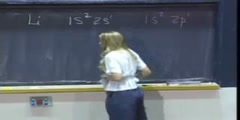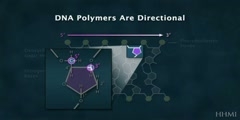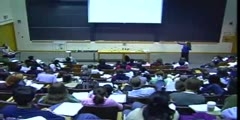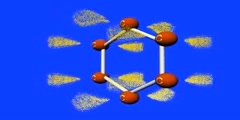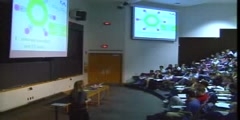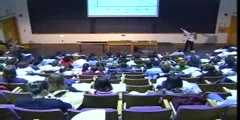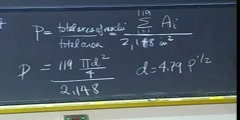Lec 24 - Determining Chemical Structure by Isomer Counting (1869)
"Lec 24 - Determining Chemical Structure by Isomer Counting (1869)" Freshman Organic Chemistry (CHEM 125) Half a century before direct experimental observation became possible, most structures of organic molecules were assigned by inspired guessing based on plausibility. But Wilhelm Körner developed a strictly logical system for proving the structure of benzene and its derivatives based on isomer counting and chemical transformation. His proof that the six hydrogen positions in benzene are equivalent is the outstanding example of this chemical logic but was widely ignored because, in Palermo, he was far from the seats of chemical authority. 00:00 - Chapter 1. How Did Kekule Know Benzene is Hexagonal? 20:10 - Chapter 2. Koerner's System of Isomer Counting and Chemical Transformation 29:53 - Chapter 3. Koerner's Assumptions on Replacement and Experimental Distinguishability 34:22 - Chapter 4. The Koerner Equivalence Proof Complete course materials are available at the Open Yale Courses website: http://open.yale.edu/courses This course was recorded in Fall 2008.
Video is embedded from external source so embedding is not available.
Video is embedded from external source so download is not available.
Channels: Chemistry (General)
Tags: Benzene Koerner Cannizzaro Isomers
Uploaded by: yalefreshorganic ( Send Message ) on 05-09-2012.
Duration: 50m 15s
Here is the next lecture for this course
Lec 25 - Models in 3D Space (1869-1877); ...
49:02 | 2625 viewsAtomic Structure and Chemical Bonding
01:54 | 10911 viewsChemical Science Electronic Structure of ...
50:05 | 12041 viewsThe Chemical Structure of DNA
02:44 | 5684 viewsChemical Bonding And Atomic Structure
07:00 | 6393 viewsChemical Science -Transition Metals - Lec ...
50:39 | 17147 viewsResonance Structure of Benzene
00:13 | 30446 viewsChemical Science - Hybridization and Chem ...
51:30 | 19711 viewsLec 9 - MIT 5.111 Principles of Chemical ...
50:04 | 2554 viewsLec 16 - MIT 5.111 Principles of Chemical ...
50:35 | 2644 viewsLec 12 - MIT 5.111 Principles of Chemical ...
50:36 | 2758 viewsChemical Science - Lewis Diagrams - Lectu ...
45:49 | 12899 viewsChemical Science - Free Energy of Formati ...
47:47 | 17279 viewsLec 4_-Benzene and Aromaticity, Huyckel Rule
01:16:07 | 2347 viewsChemical Science - Discovery of Nucleus - ...
35:15 | 21061 viewsNo content is added to this lecture.
This video is a part of a lecture series from of Yale
Lecture list for this course
Lec 2 - Force Laws, Lewis Structures and Resonance
Lec 3 - Double Minima, Earnshaw's Theorem and Plum-Puddings
Lec 4 - Coping with Smallness and Scanning Probe Microscopy
Lec 6 - Seeing Bonds by Electron Difference Density
Lec 7 - Quantum Mechanical Kinetic Energy
Lec 8 - One-Dimensional Wave Functions
Lec 9 - Chladni Figures and One-Electron Atoms
Lec 10 - Reality and the Orbital Approximation
Lec 11 - Orbital Correction and Plum-Pudding Molecules
Lec 12 - Overlap and Atom-Pair Bonds
Lec 13 - Overlap and Energy-Match
Lec 14 - Checking Hybridization Theory with XH_3
Lec 15 - Chemical Reactivity: SOMO, HOMO, and LUMO
Lec 16 - Recognizing Functional Groups
Lec 17 - Reaction Analogies and Carbonyl Reactivity
Lec 18 - Amide, Carboxylic Acid and Alkyl Lithium
Lec 19 - Oxygen and the Chemical Revolution (Beginning to 1789)
Lec 20 - Rise of the Atomic Theory (1790-1805)
Lec 21 - Berzelius to Liebig and Wöhler (1805-1832)
Lec 22 - Radical and Type Theories (1832-1850)
Lec 23 - Valence Theory and Constitutional Structure (1858)
Lec 25 - Models in 3D Space (1869-1877); Optical Isomers
Lec 26 - Van't Hoff's Tetrahedral Carbon and Chirality
Lec 27 - Communicating Molecular Structure in Diagrams and Words
Lec 28 - Stereochemical Nomenclature; Racemization and Resolution
Lec 29 - Preparing Single Enantiomers and the Mechanism of Optical Rotation
Lec 30 - Esomeprazole as an Example of Drug Testing and Usage
Lec 31 - Preparing Single Enantiomers and Conformational Energy
Lec 32 - Stereotopicity and Baeyer Strain Theory
Lec 33 - Conformational Energy and Molecular Mechanics
Lec 34 - Sharpless Oxidation Catalysts and the Conformation of Cycloalkanes
Lec 35 - Understanding Molecular Structure and Energy through Standard Bonds
Lec 36 - Bond Energies, the Boltzmann Factor and Entropy
Lec Last - Potential Energy Surfaces, Transition State Theory and Reaction Mechanism


